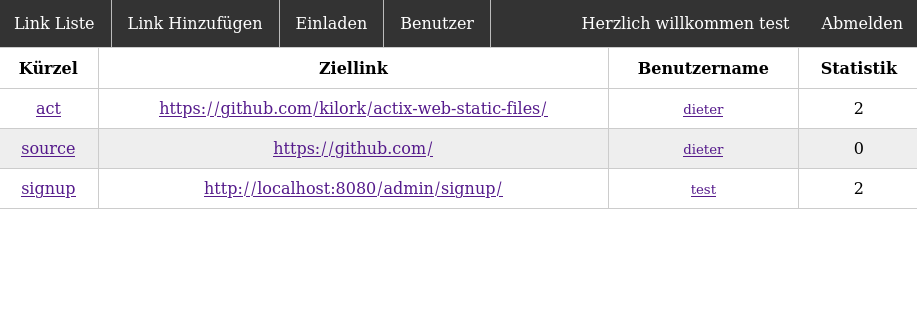Pslink a "Private Short Link page"
The target audience of this tool are small entities that need a url shortener. The shortened urls can be publicly resolved but only registered users can create short urls. Every registered user can see all shorted urls but ownly modify its own. Admin users can invite other accounts and edit everything that can be edited (also urls created by other accounts).
So in general this is more a shared short url bookmark webpage than a shorturl service.
The Page comes with a basic commandline interface to setup the environment. If it is built with cargo build release --target=x86_64-unknown-linux-musl everything is embedded and it should be portable to any 64bit linux system.
Templates and migrations are embedded in the binary. So it should run standalone without anything extra.
usage
setup
To get Pslink up and running use the commands in the following order:
pslink generate-envthis will generate a.envfile in the curent directory with the default settings. Edit this file to your liking. You can however skip this step and provide all the parameters via commandline or environmentvariable. It is not recommended to provide PSLINK_SECRET with commandline parameters as they can be read by every user on the system.pslink migrate-databasewill create a sqlite database in the location specified.pslink create-admincreate an initial admin user. As the page has no "register" function this is required to do anything usefull.pslink runserverIf everything is set up correctly this command will start the service.
run the service
If everything is correctly set up just do pslink runserver.
update
To update to a newer version execute the commands in the following order
- stop the service
- run
pslink migrate-database - run the server again
pslink runserver
help
For a list of options use pslink help.
systemd service file
If you want to automatically start this with systemd you can adjust the following template unit to your system. In this case a dedicated pslink user and group are used with the users home directory at /var/pslink. Some additional settings are in place to protect the system a little should anything go wrong.
# /etc/systemd/system/pslink.service
[Unit]
Description=Pslink the Urlshortener
Documentation=https://github.com/enaut/Pslink
Wants=network.target
After=network.target
[Service]
User=pslink
Group=pslink
EnvironmentFile=-/var/pslink/.env
ProtectHome=true
ProtectSystem=full
PrivateDevices=true
NoNewPrivileges=true
PrivateTmp=true
InaccessibleDirectories=/root /sys /srv -/opt /media -/lost+found
ReadWriteDirectories=/var/pslink
WorkingDirectory=/var/pslink
ExecStart=/var/pslink/pslink runserver
[Install]
WantedBy=multi-user.target
